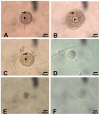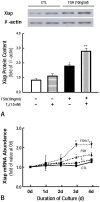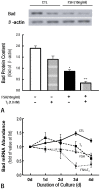Effect of different culture systems and 3, 5, 3'-triiodothyronine/follicle-stimulating hormone on preantral follicle development in mice
- PMID: 23596531
- PMCID: PMC3626649
- DOI: 10.1371/journal.pone.0061947
Effect of different culture systems and 3, 5, 3'-triiodothyronine/follicle-stimulating hormone on preantral follicle development in mice
Abstract
The mechanical method to isolate preantral follicle has been reported for many years. However, the culture systems in vitro are still unstable. The aim of this study was to analyze the effect of the culture system of mice preantral follicles on the follicular development in vitro. The results showed that the 96-well plate system was the most effective method for mice follicle development in vitro (volume change: 51.71%; survival rate: 89%, at day 4). Follicle-stimulating hormone (FSH) and Thyroid hormone (TH) are important for normal follicular development and dysregulation of hormones are related with impaired follicular development. To determine the effect of hormone on preantral follicular development, we cultured follicle with hormones in the 96-well plate culture system and found that FSH significantly increased preantral follicular growth on day 4. The FSH-induced growth action was markedly enhanced by T₃ although T₃ was ineffective alone. We also demonstrated by QRT-PCR that T₃ significantly enhanced FSH-induced up-regulation of Xiap mRNA level. Meanwhile, Bad, cell death inducer, was markedly down-regulated by the combination of hormones. Moreover, QRT-PCR results were also consistent with protein regulation which detected by Western Blotting analysis. Taken together, the findings of the present study demonstrate that 96-well plate system is an effective method for preantral follicle development in vitro. Moreover, these results provide insights on the role of thyroid hormone in increasing FSH-induced preantral follicular development, which mediated by up-regulating Xiap and down-regulating Bad.
Conflict of interest statement
Figures





Similar articles
-
Growth differentiation factor-9 mediates follicle-stimulating hormone-thyroid hormone interaction in the regulation of rat preantral follicular development.Endocrinology. 2009 Dec;150(12):5566-74. doi: 10.1210/en.2009-0262. Epub 2009 Oct 15. Endocrinology. 2009. PMID: 19833718
-
Effects of luteinizing hormone and follicle stimulating hormone on the developmental competence of porcine preantral follicle oocytes grown in vitro.J Assist Reprod Genet. 2007 Sep;24(9):419-24. doi: 10.1007/s10815-007-9154-5. Epub 2007 Jul 17. J Assist Reprod Genet. 2007. PMID: 17636438 Free PMC article. Clinical Trial.
-
Dynamic medium containing kit ligand and follicle-stimulating hormone promotes follicular survival, activation, and growth during long-term in vitro culture of caprine preantral follicles.Cells Tissues Organs. 2012;195(3):260-71. doi: 10.1159/000325150. Epub 2011 Apr 14. Cells Tissues Organs. 2012. PMID: 21494023
-
Expression of follicle-stimulating hormone receptor (FSHR) in goat ovarian follicles and the impact of sequential culture medium on in vitro development of caprine preantral follicles.Zygote. 2011 Aug;19(3):205-14. doi: 10.1017/S0967199410000511. Epub 2010 Dec 21. Zygote. 2011. PMID: 21205389
-
Role of CYP51 in the Regulation of T3 and FSH-Induced Steroidogenesis in Female Mice.Endocrinology. 2017 Nov 1;158(11):3974-3987. doi: 10.1210/en.2017-00249. Endocrinology. 2017. PMID: 28938463
Cited by
-
Effect of animal-sourced bioactive peptides on the in vitro development of mouse preantral follicles.J Ovarian Res. 2020 Sep 15;13(1):108. doi: 10.1186/s13048-020-00695-8. J Ovarian Res. 2020. PMID: 32933578 Free PMC article.
-
Role of OCT4 in the Regulation of FSH-Induced Granulosa Cells Growth in Female Mice.Front Endocrinol (Lausanne). 2020 Jan 10;10:915. doi: 10.3389/fendo.2019.00915. eCollection 2019. Front Endocrinol (Lausanne). 2020. PMID: 31998243 Free PMC article.
-
Elevated serum thyroid-stimulating hormone is associated with decreased anti-Müllerian hormone in infertile women of reproductive age.J Assist Reprod Genet. 2015 Feb;32(2):243-7. doi: 10.1007/s10815-014-0397-7. Epub 2014 Dec 9. J Assist Reprod Genet. 2015. PMID: 25488203 Free PMC article.
-
Panax ginseng Extract Improves Follicular Development after Mouse Preantral Follicle 3D Culture.Cell J. 2019 Jul;21(2):210-219. doi: 10.22074/cellj.2019.5733. Epub 2019 Feb 20. Cell J. 2019. PMID: 30825295 Free PMC article.
-
The relationship between thyroid function and ovarian reserve: a prospective cross-sectional study.Thyroid Res. 2021 Oct 1;14(1):22. doi: 10.1186/s13044-021-00112-2. Thyroid Res. 2021. PMID: 34598733 Free PMC article.
References
-
- Hsu SY, Hsueh AJ (1997) Hormonal regulation of apoptosis an ovarian perspective. Trends Endocrinol Metab 8: 207–213. - PubMed
-
- Rocha RM, Lima LF, Alves AM, Celestino JJ, Matos MH, et al. (2012) Interaction between melatonin and follicle-stimulating hormone promotes in vitro development of caprine preantral follicles. Domest Anim Endocrinol 44: 1–9. - PubMed
-
- Lima IM, Brito IR, Rossetto R, Duarte AB, Rodrigues GQ, et al. (2012) BMPRIB and BMPRII mRNA expression levels in goat ovarian follicles and the in vitro effects of BMP-15 on preantral follicle development. Cell Tissue Res 348: 225–238. - PubMed
Publication types
MeSH terms
Substances
LinkOut - more resources
Full Text Sources
Other Literature Sources
Research Materials

